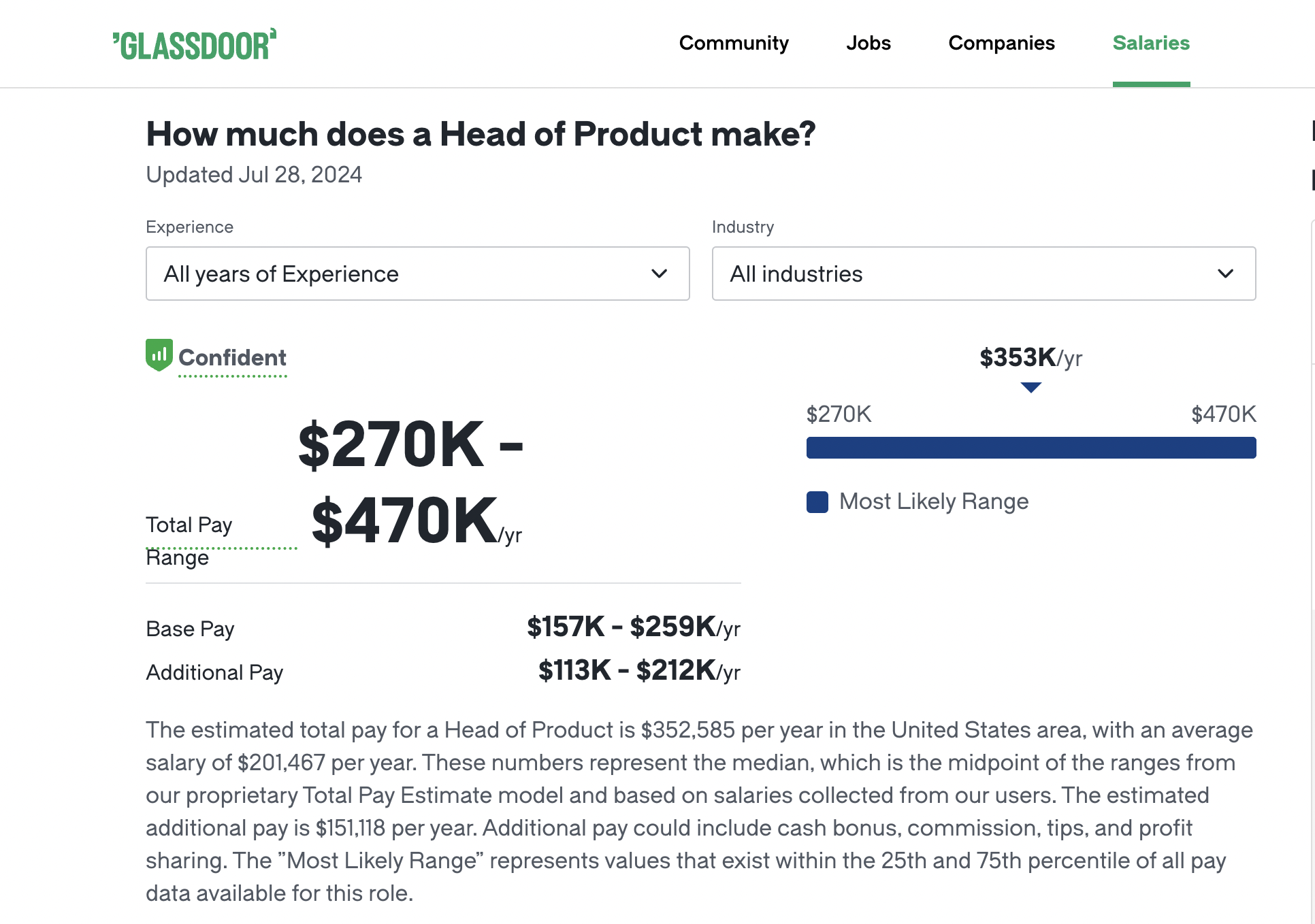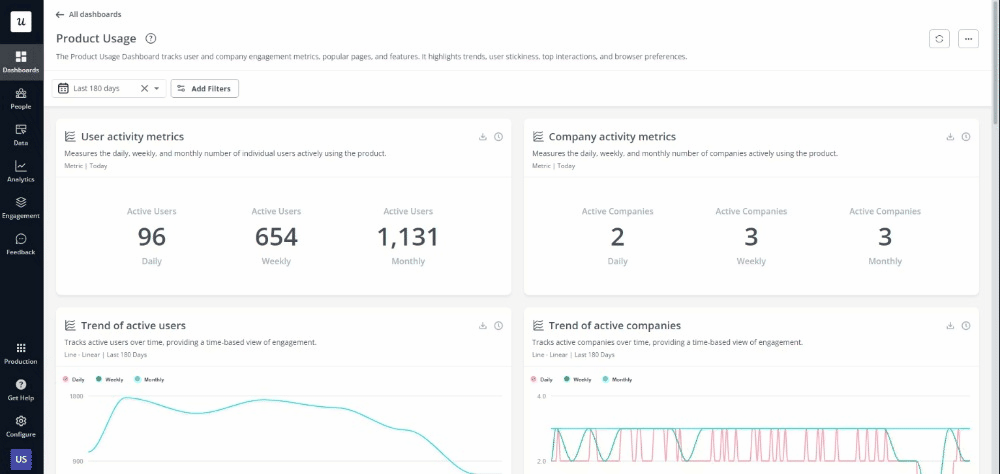
Whether you’re a seasoned professional or new to the field, understanding the nuances of head of products is essential for success.
In this guide, we’ll delve into the core responsibilities, salary insights, essential skills, and more, providing you with the knowledge and tools you need to excel as a head of product.
Try Userpilot Now
See Why 1,000+ Teams Choose Userpilot

TL;DR
- A head of product is a leadership role responsible for overseeing the development and management of a product or a portfolio of products within a company. They play a crucial role in defining the product strategy, setting the product vision, and ensuring the successful execution of product initiatives.
- Based on data from Glassdoor, the estimated total pay for a Head of Product in the United States is $352,585 per year. This includes a base salary of $201,467 per year and additional compensation of $151,118 per year (which may include bonuses, stock options, and other benefits).
- Looking into tools for head of products? Userpilot is an all-in-one product platform with engagement features and powerful analytics capabilities. Book a demo to see it in action!
What is a head of product?
A head of product is a leadership role responsible for overseeing the development and management of a product or a portfolio of products within a company. They play a crucial role in defining the product strategy, setting the product vision, and ensuring the successful execution of product initiatives.
What does a head of product do?
The specific responsibilities of a head of product can vary depending on the size and structure of the organization, but their overall goal is to drive the success of the product and contribute to the company’s growth.
Head of product’s main responsibilities
Key responsibilities of a head of product typically include:
- Defining product strategy: Conducting market research, gathering customer insights, analyzing competitor landscapes, and identifying market opportunities to shape the overall product strategy.
- Setting product vision: Articulating a clear and compelling vision for the product that aligns with the company’s goals and resonates with target users.
- Leading product teams: Managing and mentoring a team of product managers, product owners, and other product professionals, fostering collaboration and driving high performance.
- Prioritizing features: Working with stakeholders to prioritize feature development based on market needs, user feedback, and business objectives.
- Collaborating with cross-functional teams: Partnering with engineering, design, marketing, and sales teams to ensure smooth product development and successful launches.
- Monitoring product performance: Tracking key metrics and analyzing user data to assess product performance and identify areas for improvement.
Head of product salary
Based on data from Glassdoor, the estimated total pay for a Head of Product in the United States is $352,585 per year. This includes a base salary of $201,467 per year and additional compensation of $151,118 per year (which may include bonuses, stock options, and other benefits).
However, the salary range can vary widely with the total pay range between $270,000 and $470,000 per year. For example, some companies like Amazon and Google are reported to pay their Heads of Product upwards of $500,000 per year.

Head of product career path
Here’s a breakdown of a typical career path for a head of product. However, do note that the years of experience for each role are approximate and can vary depending on individual career paths and company structures. Some individuals may progress faster than others, while others may choose to specialize in a particular area of product management, such as growth, data, or platform products.
1. Associate Product Manager (0-2 years): This entry-level position is the starting point for many aspiring product managers. Associate Product Managers (APMs) typically work under the guidance of experienced Product Managers, assisting with tasks like market research, competitive analysis, feature prioritization, and user feedback collection. They gain hands-on experience with product development processes and learn the fundamentals of product management.
2. Product Manager (2-5 years): Product Managers (PMs) own a product or feature set and are responsible for its overall success. They define product strategy, prioritize features, gather requirements, and work closely with engineering, design, and marketing teams to bring the product to market. PMs also track product performance metrics and use data to inform decision-making and drive continuous improvement.
3. Senior Product Manager (5-8 years): Senior Product Managers (Sr. PMs) have more experience and typically manage a larger product or a team of PMs. They are responsible for developing and executing complex product strategies, leading cross-functional teams, and driving significant business impact. Sr. PMs often have more autonomy and influence within the organization, and they may also mentor and coach junior PMs.
4. Group Product Manager (8-12 years): Group Product Managers (GPMs) oversee a portfolio of products or a large product area. They set the overall vision and strategy for their product group, manage a team of PMs and Sr. PMs, and are responsible for achieving ambitious business goals. GPMs often interact with senior executives and stakeholders, and they play a key role in shaping the company’s product direction.
5. Director of Product (12-15+ years): Directors of Product (DPMs) are senior leaders who manage a large product organization or multiple product groups. They are responsible for the overall product strategy, roadmap, and execution across the organization. DPMs collaborate with other C-level executives to set company-wide product priorities and ensure alignment with business objectives. They also play a crucial role in developing and mentoring the next generation of product leaders.
6. Head of Product/Chief Product Officer (15+ years): This is the pinnacle of the product management career ladder. Heads of Product (HoPs) or Chief Product Officers (CPOs) are executive-level leaders responsible for all product-related activities within a company. They report directly to the CEO and are accountable for the success of the company’s entire product portfolio. HoPs/CPOs set the overall product vision, define the product strategy, and lead the company’s product culture. They also play a critical role in attracting and retaining top talent, and they are often involved in investor relations and fundraising.
Best practices for being a great head of product
Here are some best practices for excelling as a head of product, focusing on actionable strategies rather than skills or qualifications:
- Embrace a customer-centric mindset: Always prioritize understanding and advocating for the customer’s needs. This means actively seeking feedback, conducting user research, and ensuring that every decision aligns with delivering value to the customer.
- Foster a strong product culture: Cultivate a culture where everyone in the organization values the customer, understands the product vision, and is empowered to contribute to its success. Encourage open communication, collaboration, and a willingness to experiment and learn from failures.
- Prioritize ruthlessly: With limited resources and time, it’s crucial to focus on the most impactful initiatives. Learn to say “no” to less important features or projects and ensure that your team is working on the things that will move the needle most.
- Communicate effectively and transparently: Clearly articulate the product vision, strategy, and goals to your team and stakeholders. Be transparent about progress, challenges, and learnings. Effective communication fosters trust, alignment, and buy-in from all parties involved.
- Be data-driven but not data-bound: Use data to inform decision-making, but don’t let it be the sole driver. Balance quantitative data with qualitative insights and intuition to make well-rounded decisions.
- Embrace experimentation and iteration: Don’t be afraid to try new things and learn from mistakes. Encourage experimentation and iteration to continuously improve the product and stay ahead of the competition.
Head of product FAQs
Is the head of product a VP? While it’s possible for a head of product to hold a VP title, it’s not always the case. A VP is a broader executive role, often encompassing multiple departments or functions. A head of product specifically focuses on product strategy and management.
What is the difference between CEO and head of product? The CEO is the highest-ranking executive in a company, responsible for overall strategy, operations, and financial performance. A head of product is focused on a specific product or product line, developing its strategy, roadmap, and ensuring its success in the market.
What level is the head of product?
A head of product typically holds an executive-level position. They often report directly to the CEO or a VP of Product and have a significant impact on the company’s strategic direction.
What is the difference between head of product and PM?
A head of product is responsible for the overall product strategy, vision, and roadmap. They manage a team of product managers. A product manager focuses on a specific product or feature, defining requirements, managing development, and ensuring it meets customer needs.
Conclusion
We hope this guide has provided you with valuable insights into the roles, responsibilities, and rewards associated with this role.
Looking into tools for heads of product? Userpilot is an all-in-one product platform with engagement features and powerful analytics capabilities. Book a demo to see it in action!









